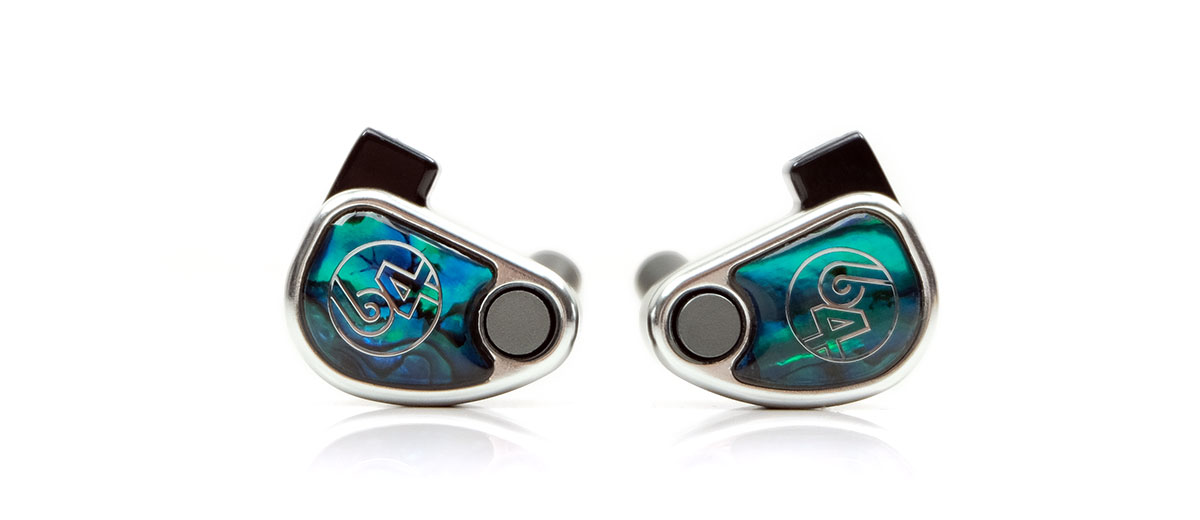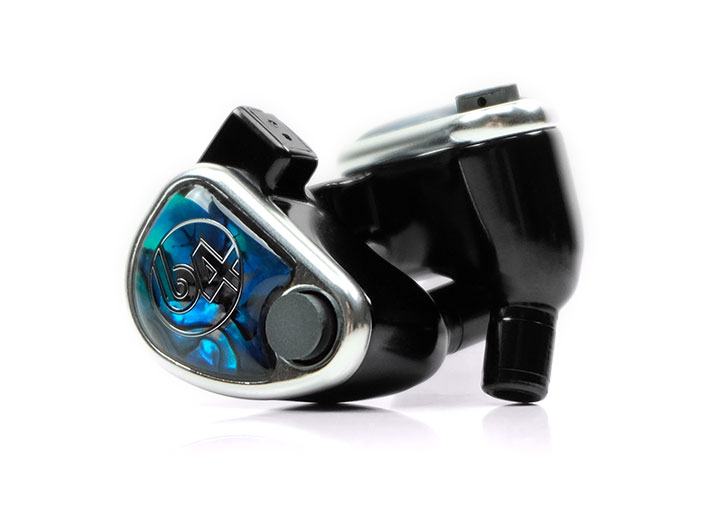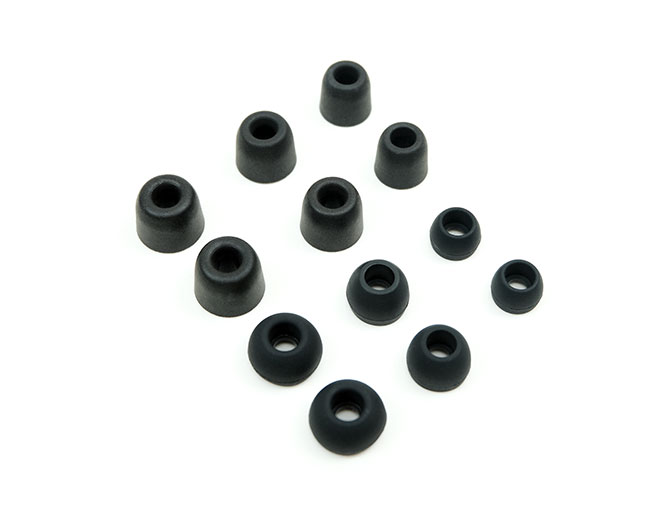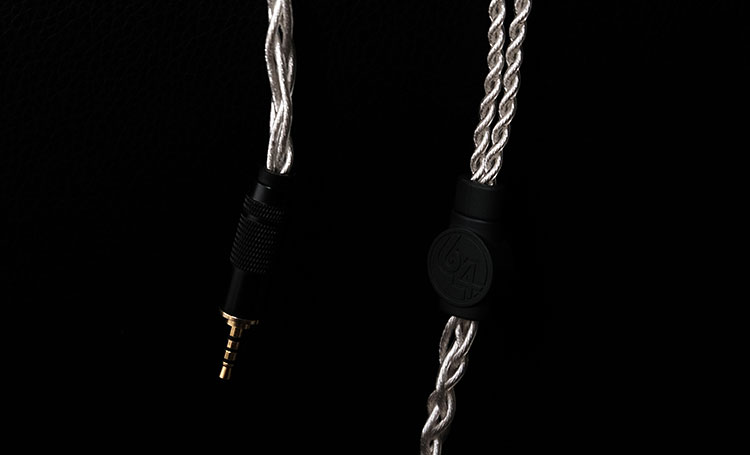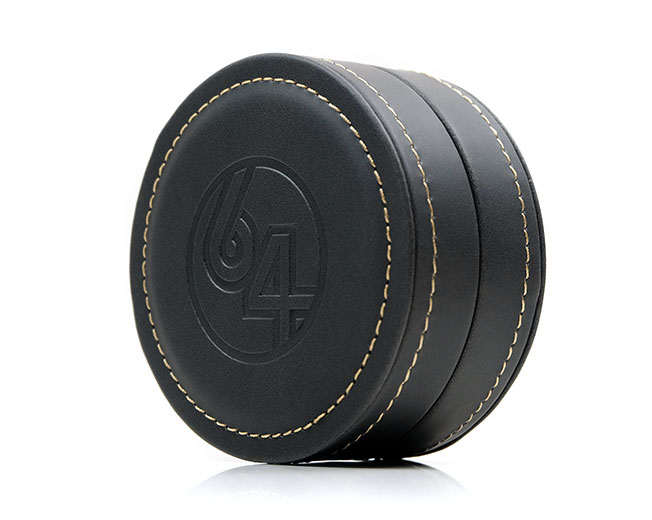The 64 Audio Nio is a hybrid universal-fit earphone featuring a 9mm dynamic driver and 8 balanced armature drivers showcasing their leading technology including tia, LID, and apex. It is priced at $1699.
Disclaimer: The 64 Audio Nio sent to us is a sample in exchange for our honest opinion in this review. We thank the team at 64 Audio for giving us this opportunity.
To read more about 64 Audio products we reviewed on Headfonics click here.
Note, this 2-page review follows our new scoring guidelines for 2020 which you can read up on here.
A hearty welcome back to Headfonics for 64 Audio who last graced us with the brilliant Trio in early 2019. This is a triple driver with their apex, LID, and tia technology and one which I love to reference and use, especially on those things we call airplanes, (hello 2020), because of its internal pressure release system.
So, with the rollout of their new hybrid universal Nio over the last few months it was a no-brainer to review it alongside their new Silver Premium IEM cable which got a simultaneous launch and priced at $499.
From what I understand the Nio is an evolution of the thinking behind their Studio Series custom monitor N8, which has a similar configuration as well as their high-end U12t models technical capability. Sadly, we do not have a U12t but rather the original A12 which has since been reviewed to the newer t-series version.
All of this is thinking behind the Nio and it still has the same price point as the N8 at $1699 which for many companies right now feels like a bit of a sweet spot for multi-driver high-end hybrid monitors.
Tech Inside
Configuration
The Nio is a 9-driver hybrid universal monitor with a single 9mm dynamic driver, 6 BA for the mids, 1 BA for the high-mids, and one tia BA for the highs. All of those are woven together using an integrated 4-way passive crossover.
The Nio also has a very low load rating at just 6Ω @1kHz but a moderate level of efficiency for SPL at 105dB. That places it very close to the Trio which is rated at 104dB SPL. I am not 100% sure though is the Trio has the same 9mm driver inside despite similar levels of efficiency.
tia
The Nio, as you would expect from most 64 Audio monitors, comes packed with their signature tech and that does include their tia technology which made its debut way back in late 2016/2017 with the likes of the original A18 model.
Tia stands for tubeless in-ear audio and is a key unique selling point for both the A18 and their current universal flagship the Fourte.
At the heart of tia is an open balanced BA design and is pitched as being far more open in sound than a sealed and tubed BA driver which quite a lot of competing monitors still use. Of course, tubeless drivers are now more prevalent in the market but each has its own unique implementation.
With the diaphragm free of obstructions the contention is that a lot of the vibrations and resonances you get with closed or tubed designs will be gone.
No more tubes and no more dampers leave more room for the chamber design and a switch to a single wide-bore nozzle. Wide bores produce a more natural sound to my ears than individual channels delivered in tubes right up to the tip.
apex
The Nio also continues to see the use of 64 Audio’s apex technology with the inclusion of 3 modules: the -10db mX module, the -15dB m15 module, and the -20dB m20 module. Aside from the M26 solid plug which is no designed for the Nio, that is the full complement of available filters.
apex is short for Air Pressure Exchange. Essentially the end goal is to reduce the level of pneumatic pressure being delivered alongside sound pressure when inserting and using an IEM or in this case a CIEM.
By reducing this type of pressure the eardrum gets less of a workover. Thus, the potential of long-term hearing damage is reduced allowing you to safely play music at a louder level than you normally can.
apex works its magic through the modules such as the m20, m15, and mX, which are designed to fit snugly into the actual shell of the Nio. Each module has an opening at the top combined with multi-cell studio-grade TPE material inside that varies in size and composition to produce different audible and sound pressure effects.
LID
The full name for this feature is Linear Impedance Design. Those of you familiar with Custom Art’s FIBAE technology will get a fairly quick understanding of the bigger aim of LID from 64 Audio.
Basically, LID ensures that whatever the impedance level is on any given output you plug the Nio into it should not have a low-Z skew and should play true to its correct tuning.
That means for those holding a 1st gen HiBy R6 Pro or a Shanling M2s ranging from 4Ω to 10Ω the Nio should sound accurate or ‘true’.
Design
It looks like 64 Audio has upped the design stakes a little on the Nio whilst retaining close to the original form factor from the Trio. These are the only two universals I have from 64 Audio with the rest coming in a custom format but from the website, you will see most of their universals have similar styling.
This is not an acrylic build rather it is a 2-piece shell design crafted from a solid block of aluminum with smooth clean lines, a polished black main shell finish, chrome fenders, and a very striking abalone blue finish faceplate.
I have come across abalone faceplates earlier this year with Campfire Audio’s Solaris SE and they do look stunning in real life. And yes, every abalone faceplate is unique since it is actually the shell of a sea snail or mollusk dried out so completely unrepeatable.
At the corner of each faceplate, you have the apex filter socket which is not something you will find on the trio since its module, (m15), was internalized. The bass vent hole for the dynamic driver is at the rear of the Nio black shell.
A few small changes to the otherwise compact form factor on the Nio. The underside is a shade flatter than the Trio with a slimmer nozzle tube at the base, (the nozzle opening is the same size). The second tweak is the 0.78mm 2-pin connector stem which is longer on the Nio.
Perhaps for strength and stability but also there are 9 drivers inside compared to 3 inside the Trio so the connection stage is essentially out of the main body on the Nio meaning more acoustical space for the drivers.
Comfort & Isolation
Comfort
The Nio is super comfortable for an aluminum body, but no surprise really since I feel the same way about the Trio also.
The soft curves and small lightweight form factor barely touch the ear or press down in an uncomfortable fashion. The longer stems might also be helping keep the cable up and away from the sides of your ear where sometimes pressure from the cable can develop.
apex Filters
The level of isolation the Nio provides is influenced by a wide range of factors. The most important point to note is that the dynamic driver inside must breathe and therefore must have a vent. This is via a rear port on the main shell. You will not get maximum isolation levels as you would from an all BA design that has no venting.
Isolation is further modified via the apex models. Each supplied filter with the Nio has a varying level of dB noise attenuation that you can pick up on right away. The mX isolates the least at -15dB with the m20 module the max at -20dB. The m15, which is the one internal to the Trio, is -15dB.
As a point of reference, the 3M Peltor X5A headphones for construction work offer up to 32dB of noise reduction and that is pitch-black silence. I am not sure the 64 Audio modules are rated using the NRR system but they will dampen down on external noise.
If you want the best isolation then grab the m20 filters but be warned, the sound signature will change with the most bass response from the Nio. The m15 takes it down a notch but with less isolation and the mX isolates the least and as you would expect, offers the least amount of bass quantity of the 3 filters.
Tips
The second factor in Nio’s level of passive isolation is a more traditional one and that is the supplied tips. The Nio included two types of tips, a foam variant called TrueFidelity in small, medium, and large as well as a set of single bore silicone tips in the same sizes.
The gap between the two tips for passive isolation was nowhere near as big as I expected it to be with both offering a reasonable level of background noise blocking. The foams will still edge it but not by a huge amount. The foam tips also feel a bit more secure in my ear compared to the softer more pliable silicone tips.
Of course, combined with the filters you are going to get a wide range of sound signatures with the two types of tips with the silicone tips sounding the lighter and cleaner of the two. I suggest using the m20 filter with the silicone tips and the m15 or mX with the foam tips but your preferences might disagree.
Cable & Connectors
The Nio is terminated with a 2-pin 0.78 connection stock which sits flush on a broad and sturdy rear stem on the rear top side of each driver. This is a design mean to be worn over the ear and complimented by a stock cable with generous amounts of memory wire to hold them in place securely.
The sockets build is excellent by the way. Cable pins glide in smoothly and you can feel a small resistance once it locks in. This is not a system that you have to put too much pressure to insert or wiggle slowly to get out so I cannot see any potential pin breaking issues arising from the Nio socket system.
Stock
The Nio stock cable is called their “Premium Cable” and can be bought separately for $129.99 directly from 64 Audio’s website. Unfortunately, the standard connection is 3.5mm if bought with the Nio whereas you can opt for 4.4mm or 2.5mm if bought separately.
There is no direct mention on the website in terms of geometry but we do know the 48″ wire is an ultra-low resistance silver-plated copper (SPC) wire and I would presume a 4-wire 28AWG in terms of gauge and density.
I have this cable already as it came with the Trio and it is actually one of the better quality stock cables with a tight braided black jacket, hand-soldered 2-pin connectors, and a very durable 3.5mm gold-plated connector.
There is, however, a slight amount of memory retention in the cable. It does have some kinks in its shape but it is not a cable that gets overly tangled. The microphonics performance of the cable is good, very quiet below the split but a bit echoey above the splitter.
It also comes with low profile memory hooks that retain their shape with ease when manipulated so they will stay close to your ear which I tend to prefer.
Premium Silver Cable
Geometry
The Premium Silver cable handles more like your traditional aftermarket IEM cable which is a good thing at $499. Inside is a 4-core 26AWG solder silver-plated OCC and silver alloy which is essentially a mix of materials designed around a 4-braid multi-core structure and silver solder with a low-resistance rating.
The wire is wrapped in a transparent and very soft jacket, more like a soft silicone than PET and close to Satin Audio’s Athena’s feel in the hand than an Effect Audio PVC jacket. The braiding is a long throw braid, not super tight but it does not need to be considering how supple that jacket is.
Handling
The premium silver cable handles beautifully and is much less prone to kinks than the stiffer premium stock cable with zero memory retention.
The microphonic performance of this cable is also excellent and much lower than the stock premium cable with next to no noise or echoes traveling up. That is likely more to do with the insulation than the splitter which is the same small rounded coin like branded plastic casing as the stock cable.
Memory wire is an additional strip of the insulation material making it fairly thick on the connector side but it is quite soft so you will not feel much pressure from it and it is shorter also compared to the very long stock cable finishing.
You can buy this in 2.5mm or 3.5mm format with the 3.5mm jack being the same durable right-angle gold-plated jack as the stock cable and the 2.5mm using a smaller and lighter black straight barrel with some grippy textured finishing circling the middle. My advice is to grab the 2.5mm and go balanced because it makes a big difference, (see page 2 sound impressions on this one).
Accessories & Packaging
The packaging has received some minor changes since my last 64 Audio universal IEM review. Instead of a lift lid box, you now have a more intricate and interesting box that slides off about 4/5th of the up to reveal an inner display presentation. The final 5th of the box that does not slide off has a memorable strapline just above the drivers and filter display area.
It is a bit of change also on the accessory line up. Aside from the drivers, filters, tips, and cable you also get the following:
- 64 Audio Personalized Protective Case
- Dehumidifier
- Cleaning Tool
- Shirt Clip
- Round Sticker
- Product Manual
Carry Case
(Just to note this is actually their older logo on the front of the case and it has been tweaked since I received the sample a few weeks back.)
The Nio carry case is an entirely new design so gone are the plastic utility cases that I actually kind of liked but were not as durable as the older Pelican cases from 5-6 years ago.
It took a bit of time to get everything neatly into that previous small container due to the wrap pillar, filter enclosures, etc whereas this new leather case is much more toss and go and more fitting for busy lifestyles.
The new rounded leather and yellow stitched case are more symbolic of where the high-end audio manufacturers are going these days with storage solutions for monitors. It is soft but strong on the outside, smells wonderfully leathery by the way, and with a distinctive 64 Audio logo embossed on the front.
The inside is free-design and spacious with plenty of room to fit in a cable or two, the monitors, and a plastic bag of tips. The sides, top, and inside of the lid are padded with a cloth material so your monitors will not suffer from any undue knocks from day to day carrying.
It is just marginally too big to be easily pocketable which the smaller plastic containers could offer but it will have no issues being thrown into small bags on the go.
Click on page 2 below for sound impressions and comparisons

